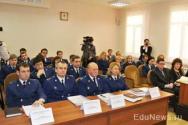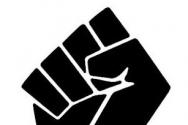Biography of Miguel Cervantes. Childhood and youth
Miguel de Cervantes short biography outlined in this article.
Miguel de Cervantes short biography
Miguel de Cervantes Saavedra- famous Spanish writer, author of the novel “The Cunning Hidalgo Don Quixote of La Mancha.”
Born presumably 29 September 1547 in a family of impoverished nobles, in the city of Alcala de Henares. When Miguel grew up, his parents were close to ruin, so he entered the service of Giulio Acquaviva y Aragon, the ambassador of the Pope, and worked for him as a housekeeper. Together they left Madrid for Rome in 1569.
Cervantes stayed under Acquaviva for about a year, and in the second half of 1570 he became a soldier in the Spanish army, a regiment stationed in Italy. This period of his biography took him 5 years and had a significant impact on his future life, since Cervantes had the opportunity to become closely acquainted with Italy, its rich culture, and social order. The famous naval battle of Lepanto on October 7, 1571 became significant for Cervantes as well. he was wounded, as a result of which only his right hand remained active. He left the hospital in Messina only in the spring of 1572, but continued military service.
In 1575, Miguel and his brother Rodrigo, also a soldier, were captured by pirates on a ship heading from Naples to Spain. They were sold into slavery and ended up in Algeria. The presence of letters of recommendation to the king helped Cervantes avoid heavy punishments and death. Four attempts to escape ended in failure, and only 5 years later, in 1580, Christian missionaries helped him gain freedom.
A life full of misadventures was replaced by the monotony of civil service and the constant search for a means of livelihood. The beginning of literary activity also dates back to this period. Almost 40-year-old Cervantes wrote in 1585 the pastoral novel Galatea and about 30 plays, which did not make much of an impression on the public. The income from writing was too small, and the writer moved from Madrid to Seville, where he took a job as a commissar for food supplies. During the 6-year period of service, he had to be arrested three times: such consequences were caused by negligence in record keeping.
In 1603, Cervantes retired and the following year he moved from Seville to Valladolid, which was the temporary capital of Spain. In 1606, Madrid was proclaimed the main city of the kingdom - Cervantes moved there, and the most successful creative period is associated with this city in his biography.
In 1605, the first part of Cervantes's greatest novel was published - "The cunning hidalgo Don Quixote of La Mancha", which, being a parody of chivalric romances, became a real encyclopedia of life in Spain in the 17th century. But world fame I didn’t come to Cervantes right away.
The second part of the novel was written only 10 years later, and during this period a number of works were published that strengthened his fame as a writer: the second most important work is “Edifying Novels” (1613), a collection of “8 Comedies and 8 Interludes.” At the end creative path a love adventure novel appeared called “The Wanderings of Persilius and Sikhismunda”. Despite his fame, Cervantes remained a poor man, living in a low-income area of Madrid.
In 1609 he became a member of the Confraternity of the Slaves of the Most Blessed Sacrament; his two sisters and wife took monastic vows. Cervantes himself did the same thing - he became a monk - literally on the eve of his death.
Personal life of Cervantes
On December 12, 1584, Miguel Cervantes married a nineteen-year-old noblewoman from the city of Esquivias, Catalina Palacios de Salazar, from whom he received a small dowry. He had one illegitimate daughter, Isabel de Cervantes.
Miguel de Cervantes - famous writer Spain 16th century. The most popular is his novel “The Cunning Hidalgo Don Quixote of La Mancha,” which had a tremendous influence on the development of all world literature.
Miguel de Cervantes: biography. early years
The future writer came from an impoverished noble family that lived in Alcala de Henares. The father was a simple doctor, his name was Hidalgo Rodrigo. Mother, Leonora de Cortina, was the daughter of a nobleman who squandered his entire fortune. In addition to Miguel, there were six children in the family; the writer himself was born the fourth.
The official date of birth of Cervantes is September 29, 1547. Since there is very little information about this period of his life, the day was calculated by church calendar- there was a tradition of giving children names in honor of saints whose holiday coincided with the time of the birth of the child. And on September 29, the day of the Archangel Michael was celebrated. Spanish version named Miguel.
There are several assumptions about the education of Cervantes. Some historians are sure that he graduated from the University of Salamanca. Others say that the writer studied with the Jesuits in Seville or Cordoba. Both versions have a right to exist, since no evidence has survived.
It is known for certain that Cervantes left his hometown and moved to Madrid. But the reasons for this action are unclear. Perhaps he decided to pursue his career, since he would not be able to achieve success in his homeland.
Military career
The biography of Cervantes is quite variable, since the writer lived a very long time ago, and before he gained fame, no one was interested in his life or documented the events.

Cervantes settled in Madrid. It is in this city young man was noticed by Cardinal Acquaviva, who invited Miguel to go to his service. The future writer agreed, and soon found himself in Rome, where he stayed for several years. Then he left church service and joined the Spanish army going to war with the Turks.
Cervantes took part in the Battle of Lepanto, where he fought bravely and lost an arm. He always spoke about his injury with pride. Later, the author wrote that the best warriors are those who come to the battlefield from the classroom. In his opinion, no one fights as bravely as learned men.
The injury did not cause his resignation. As soon as the wounds healed, Cervantes went to war again. He came under the command of Marcantonius Colonna and took part in the assault on Navarino. Then he served in the Spanish squadron and in the garrisons of Naples and Sicily.
In 1575, the writer decides to return to Spain. But on the way, his ship is captured by pirates. And Cervantes ends up in Algeria, where he spends 5 years in slavery. During this time, he tried to escape several times and gained incredible respect from his fellow prisoners.
Liberation
Cervantes' biography gives an idea of him as a courageous man who faced many trials. Later, his works will reflect these moments - both the description of the war and slavery.

Miguel was saved from captivity by his mother, who, being a widow, gave all her fortune to ransom her son from captivity. And in 1580, the future writer returned to his homeland. But his financial situation worsened. He had neither savings nor parental capital. This forced Cervantes to return to military service. He took part in the campaign to Lisbon, then went with the expedition to conquer the Azov Islands. He never gave up and it was impossible to break him.
First work
Cervantes' biography is full of trials and dangers. Despite his active lifestyle, he managed to find time to write even in the dungeons of Algeria. But he took up this professionally only after finishing his military career and returning to Spain.
His first work was the shepherd's novel Galatea, dedicated to the son of Colonna. The work included inserts from the author's life and various poems in Italian and Spanish tastes. However, the book was not a great success.
It is believed that the writer’s beloved, whom he married in 1584, was hiding under the name Galatea. She had a high birth, but was without a dowry. Therefore, the couple lived in poverty for a long time.

Literary career
Miguel Cervantes wrote a lot for the theater. A brief biography of the writer reports that there were about 20-30 plays in total. Unfortunately, only two of them have survived. Even the comedy “Lost,” which Cervantes himself called his best play, was lost.
But writing could not support his family, and life in Madrid was not cheap. The plight forced the writer to move his family to Seville. Here he managed to get a position in the financial department. But the salary was extremely low. Cervantes lived in Seville for 10 years, but very little is known about this period. It is clear that he continued to be in great need of money, since he also supported his sister, who gave her part of the inheritance to ransom her brother from captivity. During this time he wrote several poems and sonnets.
Last years and death

The biography of Cervantes Saavedra is interrupted for some time. They remain hidden from researchers for several years. He appears on stage again in 1603 in Valladolid. Here the writer carries out small tasks, which make up his entire income. In 1604, the first part of Don Quixote appeared, which brought its author dizzying success. However, this did not improve his financial situation, but it helped Cervantes become convinced of his literary talent. From that time until his death, he began to actively write.
He continued to work even on his deathbed, and shortly before his death he decided to become a monk. Cervantes died from dropsy, which tormented him for a long time. This happened on April 23, 1616 in Madrid, where the writer moved shortly before his death. For many years his grave was lost, as there was no inscription on the tombstone. The remains of Cervantes were discovered only in 2015 in the crypt of the Monastery de las Trinitarias.
"Don Quixote"
The biography of Cervantes is primarily the life story of the author of Don Quixote. This novel is recognized as one of the greatest literary creations in the entire history of mankind. The work received recognition during the author’s lifetime. The name of Cervantes became known not only in his homeland, but also in other European countries. The first part of the novel was published in 1605, and the second exactly 10 years later.
The book brought not only success to its author, but also ridicule and bullying. And shortly before the publication of the second part, the novel “The Second Part of Don Quixote” was published, which was written by a certain Alonso de Avellaneda. This book was noticeably inferior to the original and contained many rude allusions and ridicule of Miguel himself.

Other works
We have outlined the biography of Cervantes. Now let's briefly talk about his works. In 1613, the author’s collection “Edifying Stories” was published, which collected everyday stories. Many people compare this book in terms of its fascination and themes with The Decameron.
The biography and work of Cervantes allow us to get an idea of the author’s personality. We can say that he was brave, witty and talented person, who was often unlucky in life.
The writer Cervantes (1547-1616) came from an ancient noble family. The house in which he grew up and the hospital at the monastery in which he was born in 1547 are now known to every resident of the Spanish city of Alcala de Hernanes.
The very fact that Cervantes was born in a hospital indicates the poverty of his family. The family lived with pride in their noble ancestors; stories about the exploits of the knights were passed down from generation to generation. It is not surprising that the future writer chose the military field. In 1571, he entered military service and went to war with the Turks. Commander-in-Chief Don Juan provided him with letters of recommendation, but Cervantes was unlucky. He was captured and transported to Algeria. The letters found on him helped save his life, but not his freedom. The Turks decided that he was a very important person and demanded a huge ransom. Cervantes spent several years in captivity, even serving as a galley rower, until merchants raised money to ransom him in 1580.
After fighting for three more years, Miguel de Cervantes retired and devoted himself to literary activity. But he did not become a prosperous and prosperous playwright, because his contemporary was the great Lope de Vega, with whom he had to compete on the stage! Cervantes complained that Lope de Vega had “taken over the Catholic monarchy”—so popular were his plays!
Unable to provide himself financially with the work of a playwright, Cervantes again turns to his old army connections. They are looking for a place as a quartermaster for him, and he makes food purchases for the “Invincible Armada” - that was the name of the Spanish fleet of one hundred and thirty warships, assembled to defeat the English filibusters and to help English Catholics. There were one hundred and eighty priests on the ships alone! One of them proclaimed: “We will be led by the Lord God himself, whose cause and holy faith we defend, and with such a Captain we have nothing to fear.” Alas, the armada was defeated, and Cervantes had to become a food buyer for the Indian fleet. He had neither passion nor ability for business, was accused of embezzlement and spent several years in prison.
Cervantes lived the life of a soldier, a famous writer and a great sinner, a life that he called “a long indiscretion” and leaving which he “carried away on his shoulders a stone with an inscription that read the destruction of his hopes.” On April 23, 1616, in Madrid, Miguel de Cervantes met death as a true Christian, having become a monk just before his death.
He was so alien to everything material and tangible that even the tombstone on his grave stood nameless, and only in 1835 the Latin inscription “To Miguel Cervantes Saavedra, king of the Spanish poets” appeared on it.
This is what is important: while fighting and fighting, trading and going broke, serving time in the galleys and in prison, Cervantes did not give up literary creativity. True, he was unable to publish. All the enormous life experience, emotional experiences, ideas about honor and nobility, longing for lost ideals - all this was expressed in the first part of Don Quixote, published in 1604. The success was stunning - in one year the novel was republished four times. Translations into other languages followed, but along with fame came the envy of enemies, slander, new persecution by the authorities... However literary activity has already become Cervantes' main business.
After 1604, he published the second part of Don Quixote, short stories and dramatic works, the poem “Journey to Parnassus”, and only after the death of Cervantes saw the light of it new novel"Persiles and Sigismonda". The second volume of Don Quixote was structured differently than the first - there were no inserted short stories. The difference in the time of writing between them - almost eight years - had an effect.
Source (abbreviated): Literature: 9th grade: in 2 hours. Part 1 / B.A. Lanin, L.Yu. Ustinova; edited by B.A. Lanina. - 2nd ed., rev. and additional - M.: Ventana-Graf, 2016
Miguel de Cervantes Saavedra is a world-famous writer, from whose pen came the stories about the “heroic” exploits of Don Quixote and the wanderings of Persiles and Sigismunda. All his works laconically combine realism and romance, lyricism and comedy.
The beginning of life's journey
The biography of Cervantes began on September 29, 1547. His parents were not particularly wealthy. The father's name was Rodrigo de Cervantes, he was a surgeon. Mother's name is Leonor de Cortinas.
Young Miguel first received his education in his hometown of Alcale de Henares, then, due to numerous moves, he studied at schools in several other cities, such as Madrid and Salamanca. In 1569, he became an accidental participant in a street fight and was persecuted by the authorities. Because of this, Cervantes was forced to flee the country. He first went to Italy, where for several years he was a member of the retinue of Cardinal Acquaviva. It is known that after some time he enlisted in the army. Along with other fighters, he took part in a fierce naval battle near Lepanto (10/7/1571). Cervantes survived, but suffered a serious wound to the forearm, which left his left arm immobilized for life. Having recovered from his wound, he more than once visited other sea expeditions, including being a participant in the assault on Navarino.
Captivity
It is known for certain that in 1575 Cervantes left Italy and went to Spain. The commander-in-chief in Italy, Juan of Austria, presented the valiant fighter with whom the future writer hoped to receive a good place in the ranks of the Spanish army. But this was not destined to happen. Algerian pirates attacked the galley on which Cervantes was sailing. The entire crew and passengers were taken prisoner. Miguel de Cervantes Saavedra was among the unfortunate. He was subjected to harsh conditions of slavery for five years. Together with other prisoners, he made more than one attempt to escape, but each time they ended unsuccessfully. These five years left an indelible imprint on the writer’s worldview. Mentions of torment and torture are found more than once in his works. Thus, in the novel “Don Quixote” there is a short story that tells about a prisoner who was kept in chains for a long time and tortured with unbearable torture. In it, the writer illustrates his own life in slavery.
Liberation
Cervantes's mother, who by that time was already a widow, sold all her small property in order to ransom her son. In 1580 he returned to his hometown. Many of his comrades who remained in captivity lamented that the adviser and comforter, who supported everyone in the most difficult moments, left them. It was his human qualities, the ability to convince and console made him the patron of unfortunate people who were in slavery.
First works
After spending several years in Madrid, Toledo and Esquivias, he managed to marry Catalina de Palacios (December 1584) and have an illegitimate daughter with Ana Franca de Rojas.
Cervantes had no means of subsistence, so he had no choice but to go back to military service. During this period, the future Spanish writer was one of the participants in the campaign to Lisbon and participated in the military campaign to conquer the Azov Islands.
After leaving the service, he took up poetry in earnest. And before that, while in Algerian captivity, he began to write poetry and compose plays, but now this activity has become the meaning of his life. His first works were not successful. Some of Cervantes's earliest works were the tragedy "Numancia" and the comedy "Algerian Manners". The novel Galatea, which was published in 1585, brought Miguel fame, but he did not become richer. The financial situation remained deplorable.

10 years in Seville
Under the yoke of poverty, Miguel Cervantes leaves for Seville. There he receives a position in the financial department. The salary was small, but the writer hoped that in the near future he would receive a position in America. However, this did not happen. After living in Seville for 10 years, he was unable to make a fortune. Firstly, as a food commissar he received a meager salary. Secondly, some of it went to support his sister, who gave her part of the inheritance to ransom her brother from Algerian captivity. The works of that time include the short stories “The Spanish Flu in England”, “Rinconet and Cortadilla”, as well as individual poems and sonnets. It should be noted that it was the cheerful disposition of the indigenous people of Seville that determined the appearance of a certain comedy and playfulness in his works.
The Birth of Don Quixote
Cervantes' biography continued in Valladolid, where he moved at the beginning of the 17th century. At this time, the residence of the court was located there. The means of subsistence were still not enough. Miguel earned money by carrying out business assignments for private people and literary work. There is information that one day he became an involuntary witness to a duel that took place near his house, during which one of the courtiers died. Cervantes was summoned to court, he was even arrested, as he was suspected of complicity and concealing information from the investigation about the causes and course of the quarrel. He spent some time in prison while the trial was ongoing.
One of the memoirs contains information that it was under arrest, while in prison, that the Spanish writer decided to write a humorous work about a man who “went crazy” from reading novels about knights, and set off to perform knightly feats in order to be like the heroes of his favorite books .
Initially, the work was conceived as a short story. When Cervantes, released from arrest, began work on his main creation, new thoughts appeared about the development of the plot, which he put into practice. This is how Don Quixote became a novel.

Publication of the main novel
In mid-1604, having completed work on the book, Cervantes began to work on its publication. To do this, he contacted the bookseller Robles, who became the first publisher of the great work. "The Cunning Hidalgo Don Quixote of La Mancha" was published at the end of 1604.

The circulation was small and sold out almost immediately. And in the spring months of 1605, the second edition was published, which was a stunning success. Don Quixote and Sancho Panza became one of the most beloved characters of the entire Spanish people, and they also became known in other countries, as the novel was translated and published in other languages. These heroes became participants in carnival processions in all
Last decade of life
The year 1606 will be marked for the writer by moving to Madrid. Despite the overwhelming success of Don Quixote, Cervantes continued to be in need. Under his care were his wife, sister and illegitimate daughter Isabel, who, after the death of her mother, began to live with her father.

Many of Cervantes's works were written during this period. This includes most of the stories that were included in the collection “Edifying Stories” (1613) and the poetic literary satire “Journey to Parnassus” (1614). Also in the last decade of his life, he composed many new plays and revised several old plays. They are collected in the book "Eight Comedies and Eight Interludes." The Wanderings of Persiles and Sikhismunda were also begun during this period.
The biography of Cervantes is not completely known. There are a lot of dark spots in it. In particular, there is no information about when he began work on the second part of Don Quixote. Most likely, the writer was inspired to create it by the writing of a false “Don Quixote” by a certain A. Fernandez de Avellaned, who continued storyline novel by Cervantes. This forgery contained many rude obscene statements addressed to the author himself and the characters of the book, presenting them in a bad light.
The real second part of the novel was published in 1615. And in 1637, both parts of this brilliant literary work were published under the same cover for the first time.
Already near death, the writer dictates a prologue to the novel “The Wanderings of Persiles and Sikhismunda,” which was published after his death in 1617.
A few days before his death, Cervantes became a monk. He died on April 23, 1616 in Madrid. The burial was carried out at the expense of The exact location of the burial is unknown, but most researchers believe that he was buried on the territory of one of the Spanish monasteries. The monument to the great writer was erected in 1835 in Madrid.

Cervantes' biography proves how selfless a person's desire to fulfill his calling can be. Despite the fact that literary creativity never brought him much income, this great writer He continued to create all his life. As a result, his works became part of cultural heritage those distant centuries. And now, after so much time, his novels, short stories and plays are relevant and popular.
>Biographies of writers and poets
Brief biography of Miguel Cervantes
Miguel Cervantes is an outstanding Spanish writer of the 16th century, author of the world-famous novel about Don Quixote of La Man. Born on September 29, 1547 in Alcala de Henares in a poor noble family. The father of the future writer was a surgeon. Miguel was the fourth child in large family. There are suggestions that in his youth Cervantes studied at the University of Salamanca, as well as with the Jesuits of Seville or Cordoba. In 1569, after a serious street skirmish, he fled to Rome, where he worked for some time in the retinue of Cardinal Acquaviva.
In 1571, Cervantes took part in a naval battle and was seriously wounded in the forearm. After this, his left hand remained inactive forever. He took part in many sea expeditions, visited Tunisia, Spain and even in Algerian captivity for five years. In 1580, he was finally able to return to his homeland. In December 1584 he married Catalina de Palacios. That same year, he had an illegitimate daughter from another woman. Being a retired soldier, he decided to devote himself to literary art. Cervantes's first plays were not very successful on stage. Recognition came with the pastoral novel Galatea (1585).
However, there was no large income from writing, so Cervantes moved to Seville and began working as a commissar for food supplies. He kept documentation carelessly, for which he was arrested more than once. During one of his stays in prison, the image of a man capable of knightly deeds arose in his head. This was the idea of Don Quixote. He worked on his main book for many years, opening up new perspectives for the plot. From 1600 to 1604, he worked hard to create the first part of the novel. In 1604 he moved to Valladolid, from where he negotiated with a Madrid bookseller.
At the end of 1604, “The Cunning Hidalgo Don Quixote of Laman” was published in a small edition. The novel was undoubtedly a success. This is evidenced by the fact that a second edition soon appeared in Madrid. The author himself republished his book twice with copyright amendments. Don Quixote and Sancho Panza became national heroes and participants in carnival processions in the cities of Spain. The writer’s financial situation, however, did not improve in any way; on the contrary, it became more pronounced hostility to him. The last decade of his life he worked hard and published new works. Miguel Cervantes died of dropsy on April 23, 1616, on the same day as the great Shakespeare.








